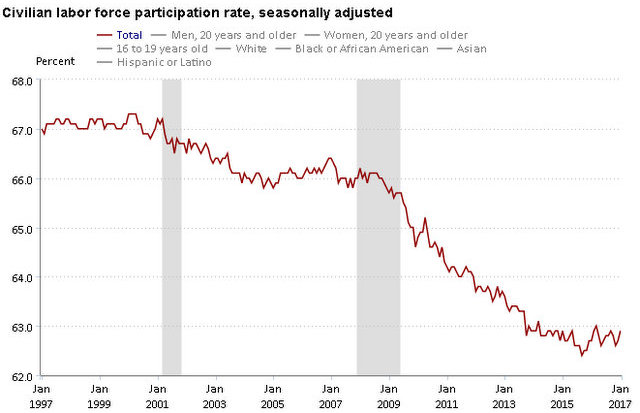Washington, DC…According to the Bureau of Labor Statistics Nonfarm payroll employment rose by 227,000 in January, and the unemployment rate was little changed at 4.8 percent. Job gains occurred in retail trade, construction, and financial activities. In 2016, job gains averaged 187,000 per month. Incorporating revisions for November and December, which decreased nonfarm payroll employment by 39,000 on net, monthly job gains have averaged 183,000 over the past 3 months.

Retail trade employment rose by 46,000 in January and by 229,000 over the year. Three industries added jobs in January–clothing and clothing accessories stores (+18,000), electronics and appliance stores (+8,000), and furniture and home furnishing stores (+6,000).
Construction employment rose by 36,000 in January. Employment increased in residential building (+9,000) and continued to trend up among residential specialty trade contractors (+11,000). These residential components have accounted for three-fourths of the 170,000 jobs gained in construction over the past 12 months.
Financial activities added 32,000 jobs in January. The
industry added an average of 15,000 jobs per month in 2016. Over
the month, gains occurred in real estate (+10,000), insurance
(+9,000), and credit intermediation (+9,000).
Employment growth continued in professional and technical
services (+23,000), in line with the average monthly gain over
the prior year. In January, computer systems design added 13,000
jobs.
Employment in food services and drinking places continued
to trend up in January (+30,000). The industry has added 286,000
jobs in the past 12 months.
Health care employment also continued to trend up in
January (+18,000), following a gain of 41,000 in December. Over
the past 12 months, health care has added 374,000 jobs.
Average hourly earnings of all employees on private nonfarm
payrolls rose by 3 cents in January, following a gain of 6 cents
in December. Over the past 12 months, average hourly earnings
have risen by 2.5 percent. From December 2015 to December 2016,
the Consumer Price Index for All Urban Consumers (CPI-U)
increased by 2.1 percent (on a seasonally adjusted basis).
Turning to measures from the survey of households, both the
unemployment rate, at 4.8 percent, and the number of unemployed
people, at 7.6 million, remained little changed in January.
There were 1.9 million unemployed people who had been looking
for work for 27 weeks or more, representing 24.4 percent of the
unemployed.
The labor force participation rate rose to 62.9 percent in
January, and the employment-population ratio edged up to 59.9
percent. Both measures held fairly steady in 2016.
In January, there were 5.8 million people working part time
for economic reasons (also referred to as involuntary part-time
workers), little changed over the month.
Among those neither working nor looking for work in
January, 1.8 million were marginally attached to the labor
force, down by 337,000 from a year earlier. Discouraged workers,
a subset of the marginally attached who believed that no jobs
were available for them, numbered 532,000 in January, little
changed from a year earlier. (People who are marginally attached
to the labor force had not looked for work in the 4 weeks prior
to the survey but wanted a job, were available for work, and had
looked for a job within the last 12 months.)
Following our usual practice, there were routine annual
adjustments to the data from our two surveys. The establishment
survey data released today reflect the incorporation of annual
benchmark revisions. Each year, we re-anchor our sample-based
survey estimates to full universe counts of employment,
primarily derived from the Quarterly Census of Employment and
Wages, which enumerates jobs covered by the unemployment
insurance tax system. The effect of these revisions on the
underlying trend in nonfarm payroll employment was minor.
(Additional information about the benchmark revision and its
impact is contained in our news release and on our website at
www.bls.gov/web/empsit/cesbmart.htm.)
Household survey data for January reflect updated
population estimates from the U.S. Census Bureau. Again this
year, the impact of the new population controls on the
unemployment rate and other ratios was negligible. (Further
information can be found in our news release and on our website
at www.bls.gov/web/empsit/cps-pop-control-adjustments.pdf.)
In summary, nonfarm payroll employment rose by 227,000 in
January, and the unemployment rate was little changed at 4.8
percent.


